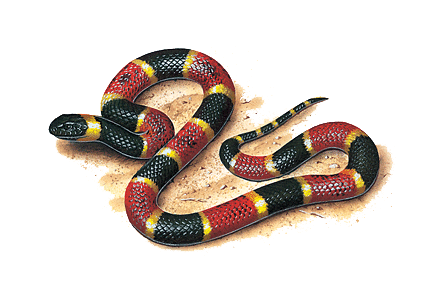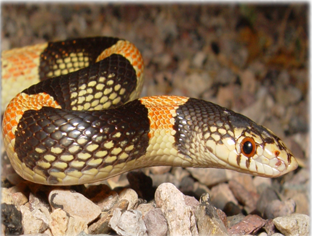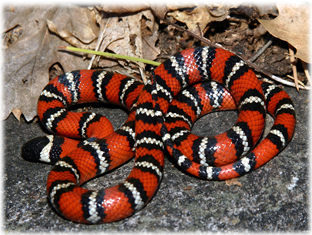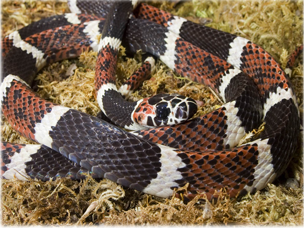 Coral snakes are most notable for their red, yellow/white, and black colored banding. In some regions, the order of the bands distinguishes between the non-venomous mimics and the venomous coral snakes, inspiring some folk rhymes — "Red on yellow, kill a fellow; red on black, friend of Jack.” Most species of coral snake are small in size. North American species average around 3 feet in length, but specimens of up to 5 feet.
Coral snakes vary widely in their behavior, but most are very elusive, fossorial snakes which spend the vast majority of their time buried beneath the ground or in the leaf litter of a rainforest floor, only coming to the surface during rains or during breeding season. Coral snakes use a pair of small fangs, which are fixed in the front of their top jaw, to deliver their venom. Due to the time it takes for the venom to take effect, coral snakes have a tendency to hold on to a victim when biting, unlike vipers which have retractable fangs and tend to prefer to strike and let go immediately. Most coral snake bites occur because of accidental handling of the snake while engaged in an activity like gardening.
Coral Snakes are found in the southern Coastal Plain from North Carolina to Louisiana, including all of Florida. They can be found in pine and scrub oak sandhills habitats in parts of this range but sometimes inhabit hardwood areas.
Coral snakes are most notable for their red, yellow/white, and black colored banding. In some regions, the order of the bands distinguishes between the non-venomous mimics and the venomous coral snakes, inspiring some folk rhymes — "Red on yellow, kill a fellow; red on black, friend of Jack.” Most species of coral snake are small in size. North American species average around 3 feet in length, but specimens of up to 5 feet.
Coral snakes vary widely in their behavior, but most are very elusive, fossorial snakes which spend the vast majority of their time buried beneath the ground or in the leaf litter of a rainforest floor, only coming to the surface during rains or during breeding season. Coral snakes use a pair of small fangs, which are fixed in the front of their top jaw, to deliver their venom. Due to the time it takes for the venom to take effect, coral snakes have a tendency to hold on to a victim when biting, unlike vipers which have retractable fangs and tend to prefer to strike and let go immediately. Most coral snake bites occur because of accidental handling of the snake while engaged in an activity like gardening.
Coral Snakes are found in the southern Coastal Plain from North Carolina to Louisiana, including all of Florida. They can be found in pine and scrub oak sandhills habitats in parts of this range but sometimes inhabit hardwood areas.
 Coral snakes are most notable for their red, yellow/white, and black colored banding. In some regions, the order of the bands distinguishes between the non-venomous mimics and the venomous coral snakes, inspiring some folk rhymes — "Red on yellow, kill a fellow; red on black, friend of Jack.” Most species of coral snake are small in size. North American species average around 3 feet in length, but specimens of up to 5 feet.
Coral snakes vary widely in their behavior, but most are very elusive, fossorial snakes which spend the vast majority of their time buried beneath the ground or in the leaf litter of a rainforest floor, only coming to the surface during rains or during breeding season. Coral snakes use a pair of small fangs, which are fixed in the front of their top jaw, to deliver their venom. Due to the time it takes for the venom to take effect, coral snakes have a tendency to hold on to a victim when biting, unlike vipers which have retractable fangs and tend to prefer to strike and let go immediately. Most coral snake bites occur because of accidental handling of the snake while engaged in an activity like gardening.
Coral Snakes are found in the southern Coastal Plain from North Carolina to Louisiana, including all of Florida. They can be found in pine and scrub oak sandhills habitats in parts of this range but sometimes inhabit hardwood areas.
Coral snakes are most notable for their red, yellow/white, and black colored banding. In some regions, the order of the bands distinguishes between the non-venomous mimics and the venomous coral snakes, inspiring some folk rhymes — "Red on yellow, kill a fellow; red on black, friend of Jack.” Most species of coral snake are small in size. North American species average around 3 feet in length, but specimens of up to 5 feet.
Coral snakes vary widely in their behavior, but most are very elusive, fossorial snakes which spend the vast majority of their time buried beneath the ground or in the leaf litter of a rainforest floor, only coming to the surface during rains or during breeding season. Coral snakes use a pair of small fangs, which are fixed in the front of their top jaw, to deliver their venom. Due to the time it takes for the venom to take effect, coral snakes have a tendency to hold on to a victim when biting, unlike vipers which have retractable fangs and tend to prefer to strike and let go immediately. Most coral snake bites occur because of accidental handling of the snake while engaged in an activity like gardening.
Coral Snakes are found in the southern Coastal Plain from North Carolina to Louisiana, including all of Florida. They can be found in pine and scrub oak sandhills habitats in parts of this range but sometimes inhabit hardwood areas.




